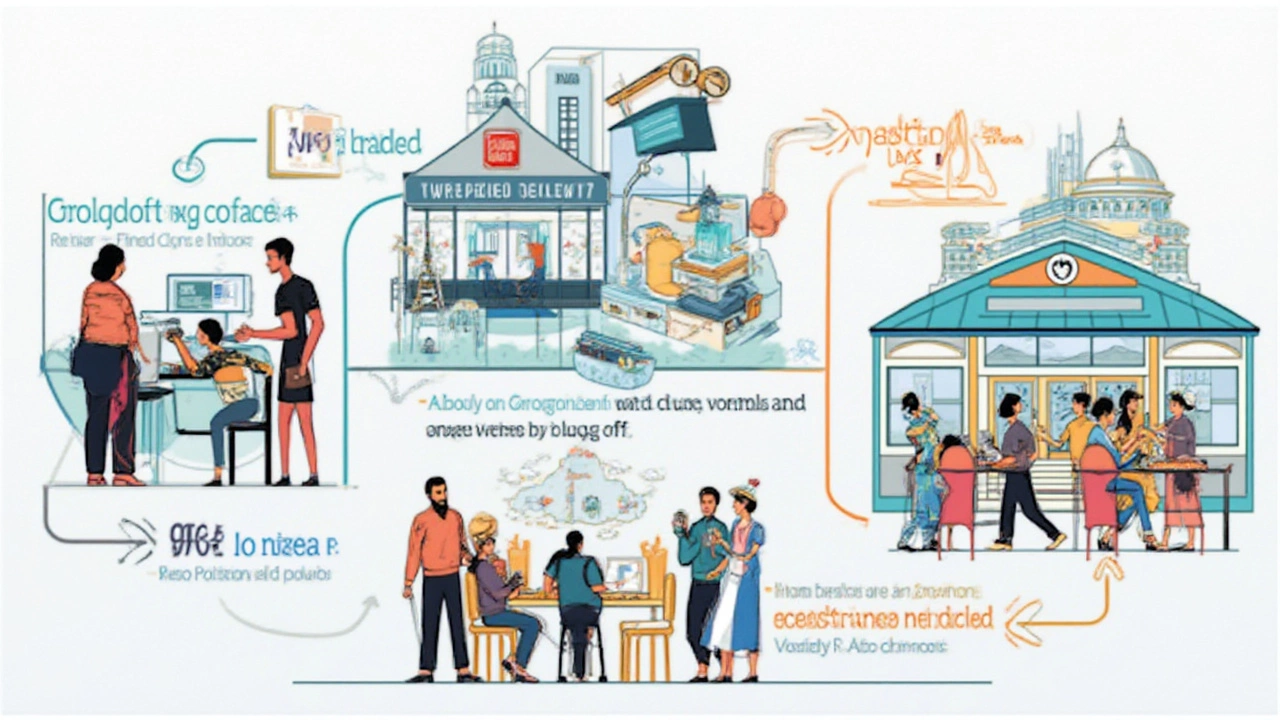![Which US Department Provides Job Training Programs? [2025 Guide & Facts]](/uploads/2025/07/which-us-department-provides-job-training-programs-2025-guide-facts.webp)
Every year, millions of Americans look to boost their skills, snag a better job, or get back into the workforce after layoffs or life changes. Where do they turn? Some folks start with a quick online search, realize there's a maze of government programs, and wonder, "Who really runs this stuff?" Here's something surprising: most of the sprawling world of federal job training is coordinated by the United States Department of Labor—but that's not the full story.
Digging into job training programs isn’t just for people out of work or young people fresh out of school. In today’s job market, you’re almost expected to keep learning something new. Automation, AI, and industry shake-ups are pushing workers in every field—construction, tech, healthcare, you name it—to stack up new certifications. And don’t think these resources are out of reach. Billions of federal dollars flow into local programs yearly, ready to help Americans build careers, not just land dead-end jobs. So, if you’ve wondered which US department has your back or what programs actually work, you’re in the right place.
Meet the Key Player: US Department of Labor and Its Partner Agencies
The US Department of Labor (DOL) wears the crown when it comes to job training. The DOL’s Employment and Training Administration (ETA) is where most federal job training funds are managed. It’s not just about training for the sake of learning—they’re focused on getting people into actual jobs, upgrading skills, or switching careers entirely. Their crown jewel? The Workforce Innovation and Opportunity Act, known everywhere as WIOA.
WIOA is a game changer. It shapes everything from the layout of American Job Centers (AJCs) to how training programs get accreditation. As of 2024, more than 2,400 AJCs operated nationwide, staffed with career experts, resume workshops, and links to local employers. Anyone—high school dropouts, veterans, single parents—can walk into an AJC and get help. In fact, last year, AJCs reported over 4 million in-person visits and helped almost 1.8 million people find a job or access training. Stuck at a dead-end job? AJCs can connect you to free or low-cost certification courses or even help subsidize an apprenticeship.
DOL doesn’t work alone. The US Department of Education teams up with the DOL to support vocational training, especially through Career and Technical Education (CTE). Then there's the Department of Health and Human Services (HHS), which supports job programs for folks on public assistance. Veterans get special options through the Department of Veterans Affairs (VA), while the Department of Agriculture funds rural training initiatives. But when it comes to nationwide workforce development, the DOL stands front and center.
Ever wondered where the money comes from? DOL’s job training budget in 2024 hovered around $10.5 billion just for workforce programs—most of it distributed to states, cities, and nonprofits. States then mix federal money with local dollars, customize the programs, and serve their unique populations: urban, rural, young, or aging workers.
| Department | Main Programs | Key Audiences |
|---|---|---|
| Labor | WIOA, Apprenticeships, Job Corps, Unemployment Training Programs | Unemployed, Youth, Dislocated Workers, Re-entry Workers |
| Education | Perkins CTE, Adult Basic Education, Literacy | Students, Adults Seeking GED/HS Completion |
| Veterans Affairs | Veterans Readiness and Employment, GI Bill Training | Veterans, Military Families |
| Agriculture | Rural Capacity Building, SNAP E&T | Rural & Agricultural Workers |
| Health & Human Services | TANF Work Programs | Low-income Families, Public Assistance Recipients |
Let’s talk about one of DOL’s best known success stories: Job Corps. This program targets people ages 16-24, especially from low-income backgrounds, and delivers free hands-on training in fields like healthcare, construction, and computer tech. In 2024 alone, nearly 40,000 participants completed Job Corps, with 78% landing jobs within six months. If you have a teen, this federal program can be a powerful launchpad—beyond what a high school guidance counselor might even know about.

How the Programs Work (And What They Can Actually Do for You)
So, what happens when someone wants to use these programs? It usually starts at the local level: someone walks into a nearby American Job Center, or hops onto CareerOneStop.org, the Labor Department’s gateway website. You’ll find quick assessments that match your strengths with real jobs, local training providers, and options you may not have considered—such as apprenticeships.
Let’s clear up some myths. You don’t have to be unemployed to use these services. A ton of people use job training programs to switch fields or get promotions. Want to move from retail to IT? DOL-sponsored "bootcamps" partner with tech employers. Thinking about a career in the trades? Registered Apprenticeships can pay you while you learn—think $17–25 per hour for entry-level electricians or HVAC technicians. In fact, DOL data from 2024 showed that 94% of apprenticeship graduates found full-time jobs, and their average starting salaries shot up to nearly $78,000 a year. Not bad, right?
If you’re a laid-off worker, WIOA funds can pay for two-year associate degrees, trucking school, or certifications like CompTIA A+ (for IT) or Certified Nursing Assistant (CNA). The DOL maintains a list of "in-demand occupations" for every state, so the training you receive is tied to real local hiring needs. This means you won’t finish a program only to realize no one in your hometown is hiring. A state like Ohio, for example, may funnel training dollars into advanced manufacturing, while Florida pushes healthcare and tourism training.
For people with barriers to employment—like the formerly incarcerated, single parents, or people recovering from addiction—there are tailored services and wraparound support like childcare vouchers and transportation stipends. States often have special "priority of service" rules for veterans, so former military get to the front of the line for some retraining dollars. And since remote work is now a huge part of the economy, many programs teach digital skills, video interview etiquette, and project management for distributed teams.
The process isn’t just a handout. Participants are encouraged to build a customized plan with a career coach. You’ll probably go through a skills assessment, line up training providers, set milestones, and check in regularly. Some states even have outcome-based funding, where the provider only gets paid if you get placed into a solid job—so there’s a real incentive to make sure you succeed, not just sign up and drift along.
One cool inside tip: don’t overlook short-term certificate programs. Recent research by Georgetown’s Center on Education and the Workforce found that folks with a short-term credential (like 10 weeks in a logistics bootcamp) can boost their pay by up to $8,000 per year compared to those with only a high school diploma. That’s a sizable jump for a short investment.
- Check eligibility on CareerOneStop or your state’s Department of Labor site.
- Visit or call your local American Job Center (findable through your ZIP code).
- Ask about "Individual Training Accounts" (ITAs)—these are what actually fund your tuition or materials.
- Don’t wait for job loss—some programs support "incumbent workers" preparing for technological changes.
- Use free resume review, skills assessments, and job search counseling.
Some community colleges run DOL-approved fast-track programs too. These tend to have higher graduation rates because of all the wraparound support—think career counseling, guaranteed internships, and employer matching events. National data from early 2025 showed that students in these "guided pathways" programs were more than twice as likely to graduate in under two years compared to regular degree seekers.

Lesser-Known Facts, Tips, and the Road Ahead for US Job Training
You'd think with such a huge system, everyone would know exactly what resources are out there. But here’s the truth: many people have no idea they’re eligible for free or subsidized career training, even while they’re stuck in low-wage work. In a recent national survey, more than 35% of respondents reported they’d never heard of the American Job Centers, even though there’s probably one closer than their favorite grocery store.
Don’t assume these resources are just for "blue collar" work. Tech, healthcare, and business services all have funded fast-lane training programs. For example, Amazon and Google have partnerships with the DOL to offer IT certificates recognized by thousands of employers. Big hospital systems recruit directly from certified nursing programs subsidized by WIOA dollars. Even green jobs—think wind turbine technician or solar installer—are now fast-expanding "in-demand" fields that pull serious federal backing.
Language and digital literacy support are also growing. New job seekers who aren’t fluent in English or who struggle with computers can get free classes, with teaching in person and online. This is backed by both Labor and Education departments, targeting those who might otherwise slip through the cracks. If you know someone struggling to fill out online forms or apply for jobs, point them towards their local American Job Center—they’ll walk them through every step, sometimes in multiple languages.
Let’s not skip over everyone’s favorite topic: paperwork. DOL-funded programs can require forms, but many states have streamlined everything. You can often upload docs directly through a secure app, text with your career coach, and sign forms online. Remember: programs do check your work authorization or unemployment status, but that’s mostly to ensure money gets to people who need it most.
Now, what about the gig economy? As of 2025, new pilot programs cover freelancers and "non-traditional" workers. The DOL knows that millions now work for ride-hailing, online marketplaces, or as one-person LLCs. There’s a big push to connect these independent workers with benefits, upskilling, and portable credentials—so the system won’t leave anyone behind.
A lot of people ask: "Does it actually work?" Data says yes, if you stick with it. The DOL tracks every enrollee’s outcome. Graduation rates in registered apprenticeships top 60%, with strong wage gains. Short-term training shows up in federal data as one of the most effective ways to move people out of poverty. In states with robust public-private partnerships (like Texas or Washington), job training alumni are almost twice as likely to stay steadily employed over three years versus similar groups who didn’t receive training.
- Act fast—funding windows can close quickly at the state level, especially when economic downturns spike demand.
- When choosing a training, ask what percentage of graduates land jobs in your area—and what those jobs pay.
- Follow up regularly with your career coach—they can connect you to job fairs or "hidden" employer pipelines.
- If you need special support, ask about disability or re-entry services—they get extra funding.
- Keep everything—certificates, letters, resume copies—digital and organized for future use.
One wild prediction: with AI and automation shaking up whole industries, DOL programs are set to evolve fast. Experts expect billions more in funding for digital skills and emerging sectors like green energy, biotech, and advanced logistics. Peer mentoring, virtual coaching, and AI-driven placement are already hitting pilot phases. If you’re looking to stay relevant in tomorrow’s workforce, tuning in to what the DOL and its partners are building could be your secret weapon.
Long story short—don’t let uncertainty or confusion stop you from grabbing the big advantages federal job training can offer. Your career path can zig, zag, or restart entirely. The help is there, the results pay off, and you might just land a job you never thought possible—thanks to a bunch of programs run by the DOL and a few surprising allies across America’s government landscape.
